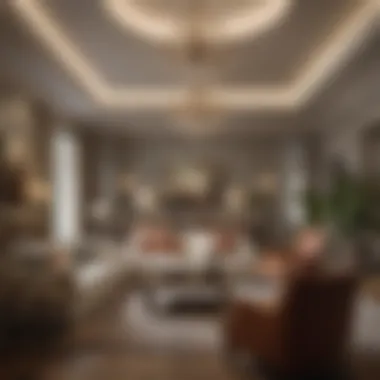Elevate Your Family Room: Sophisticated Decor Ideas


Intro
The family room serves as the heart of the home, a gathering place where families connect and memories are formed. While it may sound simple, creating a sophisticated atmosphere in this space requires more than just a splash of paint and a cozy sofa. The art of family room decor involves understanding the balance between functionality and aesthetics. It's about choosing the right layout, materials, and decorative elements that reflect personal taste while also enhancing the hints of luxury.
In this guide, we will traverse various aspects of elevating the family room—from selecting furniture that stands out to incorporating decorative lighting that enchants. We will explore trending colors, textures, and designs, all aimed at inspiring readers with visual and practical ideas for their unique spaces.
This is not merely a guide but a blueprint for crafting an elegant nook that resonates with both comfort and style. Each suggestion is infused with a sense of intentionality, allowing each element to sing in harmony rather than drown out in chaos. Let's embark on this journey to transform your family room into a sophisticated retreat where form meets function.
Outdoor Decor Ideas
Creating a visual connection between the indoor and outdoor spaces can truly enhance the sophistication of a family room. The outdoors offers a vast canvas for elegant decor ideas that invite nature's beauty inside.
Seasonal Inspirations
Decking the family room with seasonal accents can set an inviting tone for any gathering. Think crisp autumn leaves spread across a mantle or spring blossoms gracing a console table. The key is to choose decor that celebrates the changing seasons while maintaining the overall elegance of the space. This could include soft textiles in nature-inspired colors or delicate floral arrangements that mirror the outdoors.
Furniture Selection
Selecting furniture is akin to choosing the finest ingredients for a gourmet dish. Each piece should complement the others without overwhelming the space. Consider statement sofas that boast deep colors, paired with refined accent chairs or a well-crafted coffee table. Additionally, opting for high-quality, sustainable materials not only enhances aesthetics but also promotes a sense of environmental responsibility. Look for pieces crafted from reclaimed woods or ethically sourced fabrics that add depth and sustainability to the design.
Decorative Lighting
Lighting can turn a simple family room into a luxurious haven. Incorporating layers of light, such as a crystal chandelier paired with strategically placed floor lamps, sets a warm and inviting ambiance. Pendant lights over a coffee table create a cozy nook for conversation, while natural light from large windows pulls the eye towards the outdoors, bridging the interior with the beauty outside.
"The right lighting can transform a mundane space into something magical, where every corner tells a story."
– Unknown
Plant Arrangements
Integrating plant life into the decor process adds color and freshness to the family room. Consider botanical arrangements that not only beautify the space but also purify the air. Implementing low-maintenance plants like snake plants or ZZ plants can also bring a bit of nature indoors, providing a soft contrast against sleek furniture. Window sills or hanging planters can both serve as stylized accents.
Hardscaping Solutions
For those family rooms that open up to outdoor spaces, hardscaping can blur the lines between indoor and outdoor living. Patios, stone walkways, or decking can create cohesive pathways leading from the inside out. This not only extends the livable area but also acts as a foundation for any outdoor family gatherings.
Sustainable Practices
Finally, embracing sustainable practices in family room decor is increasingly relevant. Beyond material selection, consider investing in energy-efficient lighting or sourcing local artisanal decorations. Prioritizing sustainability in your design choices can lead to a sense of pride in your space while setting a precedent for responsible living.
The enticing world of sophisticated family room decor offers multitude avenues for expression and design innovation. Each choice, when made with care, can lead to a visually pleasing environment that nurtures both the soul and the spirit.
Understanding the Family Room
The family room serves as the heart of the home. It’s not just a place where everyone gathers; it embodies a sense of togetherness and belonging. Every nook and corner in this room speaks volumes about personal style, comfort, and the nuances of daily life. Thus, understanding this space paves the way for elevating it into a sophisticated environment.
In this section, we will delve into what truly defines the family room, capturing its essence and the aspects that contribute to its functionality and aesthetic appeal.
Defining the Family Room Space
Defining the family room space is essential in determining its role and influence within the home. Unlike formal living rooms, family rooms tend to be more casual and relaxed. They are designed not only for lounging but also for entertaining, engaging in activities like game nights, and even cozy movie marathons. Consider it the stage for life's memorable moments.
A well-defined family room integrates various elements that harmoniously blend together. Think of sectional sofas, soft rugs, or perhaps a large entertainment unit that centralizes the space. People often overlook the significance of the layout, but it can make or break the utility of a family room. It’s imperative to take into account how the room connects with surrounding spaces, especially in open-concept homes. Having a natural flow enhances the overall experience, making it a focal point for both relaxation and social gatherings.
Establishing Purpose and Functionality
Every family room should reflect its primary function while allowing for some versatility. Establishing purpose means knowing what activities will take precedence in the room. Is it a space for family bonding? Do children do their homework there, or do you use it primarily for entertaining guests? Knowing this dictates your decor choices, everything from furniture selections to decorative items added later.
To make the most of the space, consider these factors:
- Flexibility: Choose furniture that easily adapts to various needs. For instance, ottomans that double as storage or coffee tables that can be easily moved.
- Seating Arrangements: Opt for seating that encourages conversation. A cozy sectional with throw pillows can create an inviting atmosphere.
- Zoning: If space permits, think about zoning areas for different activities, such as reading nooks or play spaces. This assists in keeping the main area relaxed, while still making it functional.
It's not merely about aesthetics—it’s about creating an environment conducive to living life.
"A family room ought to be a reflection of cherished memories, striking a balance between comfort, style, and practicality."
By thoughtfully defining the space and establishing its purpose, you unlock the potential for the family room to evolve into an elegant retreat, merging sophistication with genuine warmth.
Aesthetic Considerations
In any decor venture, understanding the aesthetic considerations is paramount. This includes more than just what pleases the eye; it encapsulates a deeper sensibility that resonates with the lived experiences and aspirations of those inhabiting the space. The balance between beauty and functionality defines how a family room will be utilized. Within this part of the guide, we will explore ways to harmonize visual appeal with everyday comfort, creating an environment that is not only easy on the eyes but also nurturing to family interactions.
Balancing Comfort with Style
When one thinks about the family room, the mind often conjures images of cozy gatherings and restful evenings. This space serves as the heart of the home, where stories are shared and memories forged. It’s imperative to prioritize comfort without sacrificing style. Consider the size and layout of your space; oversized furniture might look inviting but can overwhelm a small room. On the other hand, sleek minimalist designs can feel cold if not balanced with inviting textures. To achieve harmony, opt for plush seating that encourages relaxation, yet also features elegant lines that speak sophistication.


Color Schemes: Embracing Harmony
Neutral Palette
Neutral colors create a seamless backdrop for any decor style, providing a canvas that allows other elements to shine. Shades like soft grays, beiges, and whites are versatile, creating a soothing atmosphere that promotes relaxation. This choice stands out as a practical yet aesthetic solution. A neutral palette seldom screams but whispers elegance. Its unique feature is the ability to accommodate various accents, allowing for easy updates without the need for an entire overhaul. An upper hand here is that neutrals tend to complement diverse tastes; however, they can sometimes feel bland if not punctuated with strategic, vibrant touches.
Bold Accents
If neutrals are your quiet strength, bold accents serve as that unexpected dash of excitement. Bold colors, like deep blues or vibrant reds, can infuse energy into your family room, acting as focal points that draw the eye. A key characteristic of these accents is their ability to define areas within the space, making them popular choices for those looking to add personal flair. Their striking nature can evoke a sense of drama yet, depending on execution, might overshadow subtler details in the room, thus requiring careful consideration of scale and placement.
Pastel Shades
On the other side of the color spectrum are pastel shades, with their soft and inviting tones. Light pinks, soft greens, and gentle yellows evoke a sense of tranquility, making them excellent choices for family-friendly spaces. The charm of pastel shades lies in their flexibility; they are perfect for creating cozy nooks or lightening more serious furnishings. Their gentle and appealing nature makes them favorable among many. However, one must be cautious, as pastels can sometimes lean towards a childish aesthetic if not combined thoughtfully with more sophisticated elements.
Choosing Textures and Materials
The tactile experience within your family room significantly contributes to its overall aesthetic. The interplay of textures invites both visual intrigue and emotional comfort. This is where choosing the right materials plays a pivotal role in elevating your decor.
Soft Furnishings
Soft furnishings, such as plush throws and velvety cushions, add layers of coziness that make a family room inviting. These particular items serve multiple functions—from aesthetic appeal to enhancing comfort for those who gather here. Their varied colors and patterns can provide personalized touches to the room, embodying both comfort and style. However, the maintenance of these pieces can be a challenge; frequent cleaning may be required to keep them looking fresh, especially in a space often used by family.
Natural Elements
Incorporating natural elements draws the outdoors in, creating a calming and fresh atmosphere. Wood accents, stone textures, and indoor plants work wonders in bringing warmth and life to your decor. Consider elements like reclaimed wood furniture or a selection of lush greenery, which can elevate a room’s appeal. The unique charm of natural materials lies in their authenticity, providing a cleanse for the eyes and soul. A downside, however, can be their cost and the upkeep involved with some plant species.
Metallic Accents
Adding metallic accents, from brass light fixtures to silver decorative items, provides a touch of glamour without overshadowing the cozier aspects of the family room. These shiny elements can quickly modernize a space, acting as conversation starters while reflecting light for a more open feel. Their versatility is a significant advantage, seamlessly blending into various styles, be it contemporary or classical. However, it's essential to use them judiciously; overdoing metallics can lead to a cluttered feel, detracting from the overall harmony in design.
Layouts and Space Planning
When it comes to designing family rooms, the layout is the backbone of the entire space. A well-planned layout is crucial to make the room both functional and visually appealing. The arrangement of furniture and decor can determine not just how the room looks, but also how it feels. Families are often looking for spaces that can adapt to various activities – from relaxed evenings with a book to lively gatherings with friends. Hence, planning the layout effectively can help create a seamless flow between these diverse activities while catering to the unique needs of families.
Open Floor Concepts
Open floor concepts are increasingly popular, offering a spacious look and feel to family rooms. By knocking down walls and allowing different areas to blend together, homeowners can create an inviting and airy atmosphere. This style supports multi-functional areas, like a kitchen flowing into the living room, which can make entertaining easier. You can use furniture placement to define different zones. For instance, a well-placed sofa may delineate the living area from a reading nook without the need for physical dividers.
- A sofa against the wall can open up the space.
- Area rugs can highlight specific areas without closing them off.
Embracing natural light is another advantage here. Large windows and an open configuration not only brightens the space but also makes it feel larger. An attentive selection of décor can enhance the openness too, such as using light colors or glass elements for furniture.
Creating Intimate Areas
While open floor plans have their merits, creating intimate zones is equally pivotal in family room design. Small, cozy alcoves can foster a sense of connection among family members, perfect for those quiet moments together. Think about a reading corner peppered with cushions—an inviting space that beckons you to relax.
To design these intimate spots:
- Use soft lighting like floor lamps or string lights for a warm glow.
- Choose furniture that promotes conversation, like a circle of chairs or a sectional sofa.
- Integrate personal touches, such as family photos or mementos, which can spark stories and connection.
These intimate areas can serve for reflection, conversation, or just unwinding with a good book. In a busy household, having such sanctuaries can provide a necessary balance, helping to refocus and recharge.
Flow and Accessibility
No matter how beautiful the decor, if guests can’t move freely, it diminishes the room’s charm. Flow and accessibility are key components of space planning. You want to ensure that pathways between furniture aren’t blocked, which means being mindful of how proximity can affect movement.
Consider the following when planning your layout:
- Allow at least 24 inches of walking space between larger furniture pieces like sofas and tables.
- Place frequently used items in easily accessible locations.
It’s all about making the room usable, enjoyable, and navigable. Good flow encourages social interaction while making the space functional, which, in turn, enhances the overall experience for everyone using the room.
"The best space planning is often invisible; it allows the occupants to engage without thinking about the layout itself."
By prioritizing these elements in design, your family room will not only look sophisticated but also serve as an inviting haven for family and guests alike.
Incorporating Furniture
In any family room, the furniture serves as more than just a functional element; it acts as a canvas upon which the style of the space is painted. The correct selection of furniture can elevate the entire atmosphere, creating an elegant and welcoming environment that is both sophisticated and livable. When it comes to incorporating furniture into a family room, it is essential to consider how each piece contributes to the overall design vision.
Choosing the right furniture not only defines the character of the room but also enhances its functionality. An artfully arranged space accommodates social gatherings, individual relaxation, or even a blend of both. Thus, striking a balance between aesthetics and purpose becomes crucial, and this is where statement pieces and thoughtful functionality come into play.
Selecting Statement Pieces


Statement pieces are furniture items that catch the eye and anchor a room’s design. They might be a chic chestnut wood coffee table with intricate detailing, or perhaps a bold sofa in a striking jewel tone that instantly draws attention. The key lies in finding those standout elements that resonate with one's personal style yet harmonize with the overall decor of the room.
Benefits of statement pieces include:
- Creating a focal point: A well-placed statement piece naturally directs the eye and dictates the layout of a room.
- Expressing personality: These pieces are often reflections of personal taste and can tell a story about the inhabitant of the space.
- Encouraging conversation: Intriguing pieces prompt discussions and can serve as conversation starters for visitors.
When selecting statement items, it is essential to assess how they interact with other elements in your room. Too many bold pieces can create visual noise, so balance is necessary. Opt for one or two dramatic items that harmonize with the room's overall color palette and theme.
Balancing Functionality with Design
The balance between functionality and design is what truly sets the stage for sophisticated decor. In a family room, furniture should not only please the eye but also serve its intended purpose. For example, consider a sectional sofa that provides ample seating yet offers a sleek silhouette that complements a modern aesthetic.
Key considerations include:
- Multi-functionality: Look for items that serve multiple purposes. A coffee table with storage or a bed that doubles as a sofa can save space while remaining stylish.
- Comfort: Don’t sacrifice comfort for style. A beautiful chair that’s hard to sit in won’t invite guests to linger.
- Fit within the space: It's vital to measure your room before selecting furniture. Oversized items in a small room can feel confining, while tiny pieces in a larger space can seem lost.
By creating a well-planned layout that incorporates statement pieces and considers functionality, the family room can transform into a sophisticated haven. It becomes a cohesive and inviting environment where both design elegance and comfortable living coexist seamlessly.
Accessorizing Thoughtfully
Accessorizing isn't merely an afterthought in family room decor; it can make or break the atmosphere of the space. Thoughtful accessorizing introduces identity, warmth, and personal touch to what might otherwise be a plain, uninspired room. The right selection of decorative elements can transform your family room into a reflection of your personality and lifestyle. It's about creating a balance—between aesthetics and practical use—that allows the family room to serve as both a hub for social activities and a cozy retreat.
Art and Wall Decor
Framed Photographs
Framed photographs are perhaps one of the most intimate touchstones in your family room, connecting the space to personal memories. They can evoke emotions—joy, nostalgia, or even humor—and serve as storytelling elements that spark conversation. By displaying images of family milestones or unforgettable trips, you create a backdrop infused with life. A key characteristic of framed photographs is their versatility: they can fit into a multitude of decor styles, from classic to contemporary.
However, a disadvantage sometimes arises when these pictures don't harmonize with the overall room design, leading to a cluttered or mismatched look. Therefore, picking frames that align with your chosen aesthetic while showcasing your family’s essence is key.
Original Artwork
Incorporating original artwork can add unparalleled depth to your family room. Unlike prints, original pieces often carry unique stories, which can resonate with viewers on a deeper level. Opting for a local artist’s work not only supports the community but also provides a unique conversational piece. The striking characteristic of original artwork is its potential for exclusivity; no one else will own exactly what you have.
The main concern is that original pieces may come with a higher price tag, which can be a drawback for those on a budget. Still, the investment can yield significant returns in the form of character and sophistication in the room's ambiance.
Mirrors
Mirrors are a dynamic accessory for any family room. They can create an illusion of space and light, making a room feel larger and more inviting. A significant characteristic of mirrors is their ability to reflect decor elements, enriching the room’s visual storytelling. Placing a well-positioned mirror can brighten up dark corners or reflect art, doubling its impact.
One disadvantage might be their maintenance—mirrors can show smudges and dust quickly, requiring conscientious upkeep. The best practice is to choose mirrors not only for their aesthetic value but also with an eye towards easy cleaning and functionality in your space.
Lighting as a Design Element
Ambient Lighting
Ambient lighting serves as the foundation of any room’s lighting scheme. It introduces a soft, inviting glow that creates a relaxed atmosphere, making it favorable for both entertaining and winding down. The characteristic of ambient lighting lies in its capability to set the mood, whether it’s warm and cozy for family movie nights or bright and lively for social gatherings.
When choosing ambient lighting, both natural and artificial sources play a role. However, relying solely on one type may cause uneven illumination. The solution lies in layering light sources to achieve a balanced and flexible lighting environment.
Task Lighting
Task lighting is another essential component that ensures functionality while adding tasteful elements to the decor. This type of lighting focuses on specific areas, like reading nooks or game tables, enabling activities without straining your eyes. The key characteristic here is precision; it allows improved visibility in targeted zones, enhancing your family’s daily activities.
On the flip side, task lighting can sometimes disrupt the overall aesthetics if not well-integrated. So, select fixtures that complement your decor style to maintain cohesion in the layout.
Accent Lighting
Accent lighting introduces flair, highlighting architectural features or decor items like artwork or plants. Its main strength is the drama it adds to a space, creating focal points that draw the eye naturally. Accent lights can be stylishly incorporated in various forms, such as sconces, spotlights, or table lamps.
However, overusing accent lighting can make a room feel disjointed. Moderation is key to ensuring your family room maintains harmony while harnessing the alluring charm of accent light.
Textiles and Soft Furnishings
Rugs
Rugs are not just decorative; they serve practical purposes as well. They define areas, add texture, and bring warmth underfoot. The characteristic of rugs is often their ability to pull a room together, anchoring the design. A well-chosen rug can effectively establish your chosen color palette, as well as add layers of comfort.
A downside to rugs is maintenance; they can get dirty or wear out under heavy foot traffic, necessitating periodic cleaning. Thus, selecting durable materials and patterns that can withstand daily life ensures your investment remains beautiful and functional.
Cushions
Cushions add comfort and a dose of style to your family room. They come in various shapes, sizes, and materials, making them a versatile accessory that can be easily swapped with seasons or trends. The key characteristic of cushions is their immediate ability to infuse color and texture without overwhelming the space.


That said, cushions can easily become clutter if not managed wisely. It's best to select a cohesive set that works well together, ensuring they enhance rather than overcrowd your seating areas.
Curtains
Curtains play a crucial role in providing privacy while enhancing the overall decor of the room. They can dramatically change how light flows in a space. A key feature of curtains is their potential for versatility; however, they can be a double-edged sword if the color or fabric is not in harmony with the room’s theme.
One possible disadvantage is the cost of high-quality fabric or custom designs, which can add up quickly. Choosing pre-made options or fabric that is budget-friendly yet stylish can help in maintaining aesthetics without breaking the bank.
A carefully accessorized family room brings not only beauty but functionality, making it a space that truly reflects the life lived within its walls.
In summary, the art of accessorizing thoughtfully allows for a personalized touch that enhances the family room’s elegance and comfort. Ensuring your decor speaks to your lifestyle and values is vital in creating a family room that is not just aesthetically pleasing, but a beloved gathering place.
Trends in Family Room Decor
The family room is often the heartbeat of a home, where conversations flow and memories are crafted. It is essential for decor choices to resonate with current trends while also reflecting personal taste. Engaging with the latest decorations helps in making the family room not only visually appealing but also functional. This section of the article explores various trends that can elevate your family room's ambiance and effectiveness.
Sustainable and Eco-Friendly Choices
With increasing awareness about environmental implications, opting for sustainable options in home decor is more than just a trend—it's a conscious lifestyle choice. Sustainable materials, like reclaimed wood or low-VOC paints, present a chic yet responsible approach to designing a family room. Integrating organic fabrics, such as bamboo or organic cotton for cushions and curtains, can add a touch of elegance while reducing your carbon footprint.
Moreover, consider furnishings made from recycled materials. Instead of plain furniture, think about pieces that tell a story. For instance, a coffee table crafted from reclaimed barn wood can be a conversation starter, blending style with sustainability. Such choices not only embellish your living space but also align your decor philosophy with a broader environmental consciousness.
Smart Home Integration
The infusion of technology into home design reflects a shift toward practicality and efficiency. Smart home integration allows for the automation of various elements within the family room. Devices can now control lighting, temperature, and even audio-visual systems seamlessly.
Imagine hosting an intimate gathering with the ability to adjust the lighting and play ambient music with just a voice command. Smart devices, like Philips Hue lights, provide an opportunity to set the mood according to the occasion—whether that’s a cozy movie night or an elegant dinner party.
These modern amenities not only enhance user experience but also instill a sense of luxury. Future-forward furnishings that integrate built-in charging ports or smart consoles redefine what it means to be comfortable in a living space, making it clear that sophistication and technology can share the same canvas.
Timeless vs. Contemporary Styles
Navigating between timeless elegance and contemporary trends can pose a challenge. The beauty of timeless decor is its adaptability. Think about classic pieces that have weathered changing tastes, such as a Chesterfield sofa or a well-crafted mahogany coffee table. These elements have the ability to anchor a room while providing a sense of history.
Conversely, contemporary styles offer a chance to experiment. They often incorporate bold colors, sleek lines, and unexpected materials. For instance, a minimalist approach might include a soak-soothing sectional paired with an abstract art piece. Striking that balance involves understanding that each design element contributes to the room’s overall narrative.
"To elevate your family room, consider blending timeless charm with contemporary flair, crafting an environment that feels both familiar and fresh."
In summation, the trends in family room decor emphasize creating spaces that not only reflect our lifestyles but also speak to the ongoing dialogues around sustainability, technology, and style. By thoughtfully considering these trends, you can transform your family room into a sophisticated retreat that remains relevant and welcoming for years to come.
Creating a Personal Narrative
Creating a personal narrative in your family room decor is not just an aesthetic choice. It’s a way to tell a story that reflects who you are, how you live, and what you cherish. The family room often serves as the heart of the home, a gathering space that showcases your taste and values. Thus, weaving your personal narrative into that space can impart warmth and authenticity that mere trends cannot achieve.
Reflecting Your Lifestyle
When designing your family room, consider the activities that frequently occur within its walls. If your family enjoys movie nights, investing in a plush sectional and a top-notch entertainment system may be crucial. For those who prefer quieter, relaxing evenings, an array of comfortable seating arranged for intimate conversation can be more fitting.
Aligning your decor with your family's daily life ensures the space is not only elegant but also functional. Think about incorporating items that facilitate interaction. A large coffee table may become the centerpiece for game nights, while shelves filled with books or games can serve as conversation starters.
In terms of aesthetics, take note of your lifestyle preferences in color and material choices. A busy family with pets might favor durable, easy-to-clean fabrics in earth tones, while a couple who enjoys entertaining may indulge in luxurious velvets and metallic accents.
"Your family room should echo the rhythm of your lives, not just your design choices."
Incorporating Family History
Family history holds the power to create a truly distinct narrative in your living space. Each piece you select can serve as a bridge to the past, evoking memories and honoring traditions. Family heirlooms, such as an antique lamp or a hand-stitched quilt, not only add character but also tie generations together in one cohesive story.
You could also consider a gallery wall displaying family photographs, framed letters, or art created by family members. This not only livens the space but also turns it into an ongoing narrative where visitors can engage with your family's journey.
Additionally, don’t shy away from unique pieces that might come from travels or special memories. A vibrant vase from Tuscany or a painting found at a Midwestern flea market can spark conversations and reveal layers of your family’s story.
Creating a personal narrative in your family room isn't just an afterthought—it's essential for evoking a sense of belonging. Your decor choices should reflect who you are and what you love, turning your family room into a sophisticated sanctuary that is unmistakably yours.
Ending: The Art of Family Room Decor
When it comes to home design, the family room acts as the heart, a sanctuary where memories are made and relaxation reigns. This article has taken a deep dive into the intricacies of elevating such an essential space. The blend of functionality and style, especially in a family room, is crucial. It is where aesthetic value meets practical needs, a delicate balance to strike.
Central to transforming a family room into a sophisticated haven is the understanding that it reflects individual tastes and familial history. It's not simply about throwing together chic furnishings; it’s about weaving an intricate tapestry of experiences, preferences, and lifestyle into the decor. The choices in furniture, lighting, and textures become a personal narrative that tells visitors who you are as much as the vibrant conversations that occur within those walls.
In discussing trends and timeless styles, one sees that purpose must lead design choices. Whether one opts for sustainable materials or the latest tech integrations, it all stems from the core aim of enriching family life. This space should not just be visually appealing but should serve as a canvas for family interactions and shared experiences. Creating elegant spaces requires forethought on how they will naturally play into daily activities—everything from children’s play to sophisticated evenings with friends.
"Elegance is not about being noticed. It's about being remembered."
The right decor does more than please the eye; it enhances the overall atmosphere of the room. Each design element acts like a note in an orchestra, contributing to a harmonious blend, from the ambient lighting to the carefully curated art pieces. As trends shift and evolve, returning to the foundational goal of creating a functional and beautiful family room is key.
Adopting the conclusions drawn from this article means considering how to incorporate elegance while preserving the inviting nature of the family room. Think about color palettes that evoke warmth, materials that invite touch, and layouts that facilitate interaction. Understanding these elements and meticulously planning them allows for a family room that doesn’t just look good but feels good, too.
Ultimately, designing a family room is an art form, the execution of which requires not just aesthetics but a keen awareness of family dynamics and lifestyle patterns. To fashion a space that is both sophisticated and personal, one must remain attentive to the details, recognizing that every choice—from the types of textiles to the arrangement of furniture—plays a role in cultivating an environment conducive to relaxation and connection.







